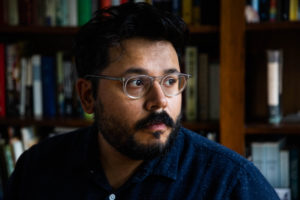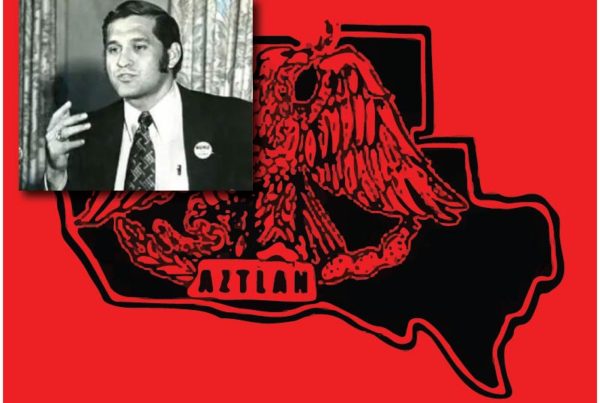What is it about a ghost story that stays with you? Is it the ghost itself or that feeling of uneasiness?
It’s this haunting feeling that Texas author Adam Soto has tapped into in his latest book, a collection of ghost stories called “Concerning Those Who Have Fallen Asleep.” Soto, who will be at the Texas Book Festival Nov. 5 and 6, spoke with the Texas Standard just in time for the spooky season about the book and how it got started. Listen to the story above or read the transcript below.
This transcript has been edited lightly for clarity:
Texas Standard: A lot of folks remember you from “This Weightless World,” which got you a whole lot of attention. Tell us a little bit about what it was like going into this second book. I would have thought that perhaps, given all the attention your first book received, it might be a little bit of pressure to match it somehow.

Author Adam Soto, who has finished a new collection of ghost stories entitled “Concerning Those Who Have Fallen Asleep,” will be at the Texas Book Festival Nov. 5-6.
Photo by Kelly West
Adam Soto: Yeah, well, fortunate for me over the course of the nearly 10 years that I was writing my first novel, I was also taking breaks and writing short stories and publishing them in various journals. And so then when “This Weightless World” was completed and it came out, I was also already sitting on a big pile of paper with a bunch of short stories in it. And I thought, “No, I’ve always wanted to do a short story collection.” And I thought that it would be a pretty good follow-up.
And so I worked from there. I realized that there was a theme in the short stories, as well. While I was writing the science fiction novel about life on another planet, I was writing short stories about death on our own. And so I just went with that.
That’s pretty grim. What was it that was motivating you to write these sorts of stories?
You know, I wish I could tell you. About half of the stories in the 13-story collection I wrote over the course of that time period. One of the very first ones that I wrote was a story called “The Box” that was about the Ebola crisis in West Africa. And that was definitely responding to things that were in the news and sparking my imagination that I think I was processing through these stories. And again, you know, it wasn’t until later that I realized that I was doing it through this vehicle of the ghost story.
We should mention for the parents are out there: These are not ghost stories for kids, mom and dad. But that’s part of the intrigue of this – it almost seems targeted at that sort of childlike element that’s in everyone. How do you characterize what that thread is that ties everything together? It’s more than just, you know, news and history.
Yeah. I think it’s picking up on these haunting elements that exist within our own real lives and our shared experience: these disasters, these looming anxieties that we carry around with us collectively – whether that’s a concern for the environment or a public health crisis or a war. Also, I think the shared inheritance of destruction in our culture, too. You know, you mentioned the Spanish flu in the context of World War I. And there’s a story that deals with slavery. And so all of these different things that we sort of carry around with us and that I think are haunting us, at least in the back of our minds, but is also the subject of much of our discourse and discussion that we share as well. A couple of days ago, somebody asked me, “Do you believe in ghosts?” And I thought, of course, this question is going to come up on a book tour for a collection of ghost stories. And I hadn’t thought about it, oddly enough. But I said, you know, I’ve seen a ghost, but I don’t believe in ghosts.
Oh, that’s epic. Would you care to elaborate on having seen a ghost?
Sure. My wife works for a home museum here in Austin, Texas, and so I would spend time there walking the grounds. It was built in the late 19th century. And one night I was just listening to music on my headphones and walking around and enjoying the early fall weather and I lost track of time. And it just got very, very dark. And I found myself alone and, you know, turned around and looked into this window. And there was just this figure of a woman in the window. It lingered long enough for me to really fixate on it. You know, I kind of studied it. I thought, “Is this a trick of the eye or …?”
And I convinced myself that there was a person staring at me and it wasn’t my wife and there was nobody else at the home. But yeah, I mean, just like in the movies, you know, I look the other way and then I turn back to give it a second glance and it was gone and replaced with a lamp. So, you know, was it the lamp the whole time? Who knows? I mean, in the moment I was shaken. So I like to say that I have seen a ghost, even if I don’t necessarily believe that ghosts are real.
I love the way that you think about it. But I’m intrigued as to why, if you see something, you’re not convinced it’s necessarily real.
Yeah. I mean, I think it’s something that I’ve learned from writing, you know, living inside of the world of a book. You have to believe in your characters. You have to believe in the way that they see the world. And sometimes the way that they see the world or their opinions are very different from your own. But you have to commit to that perspective in order to build that kind of reality. And so it’s, I don’t know, it’s not so much a suspension of disbelief rather than a suspension of your own belief. It’s difficult and sometimes a little scary depending on the types of characters that you’re writing. But it also can be just a lot of fun.
On the other end of it, you feel like you’ve lived this other life, if only momentarily, and you get to kind of carry that around with you in your memory and in your heart. I guess it’s a matter of being open to the possibility of the impossible while simultaneously maintaining, I don’t know, a sort of rational and empirical approach to existence, which is just how I choose to live my own life, I suppose, for the sake of my own sanity, really.
I guess releasing your book in October is total accident, huh?
You know, oddly enough, it is the publishing industry. It’s a wild calendar. You get in there and you have really no sense of exactly when and where it’s going to all land. And it’s just a sort of a Tetris thing that they’re doing on their end. It was originally slated to come out in September, but then the supply chain printing issues bumped it. And yeah, I thought it was great. I was like, you know, October, I think that’s perfect actually.
Just in time for Halloween and all that. But what do you hope readers are going to be taking away from your book?
I hope that they do get a bit of a fright from some of them. I think that some of the stories are definitely very frightening. But from there, I hope that they engage with the characters, you know, whether they are among the living or the dead, and that they connect to those characters’ lives and their experiences. That they learn something from the various time periods and settings that those characters exist and that they feel connected to this haunted world of the stories. That they get a couple of laughs out of some of the funnier stories and get a sort of new sense of the afterlife, because I think that some of the stories end up also really playing with popular tropes and turning them on their heads.













